合川钓鱼城遗址 山地军事防御体系建设的突出典范
2022-06-22陈元棪
陈元棪

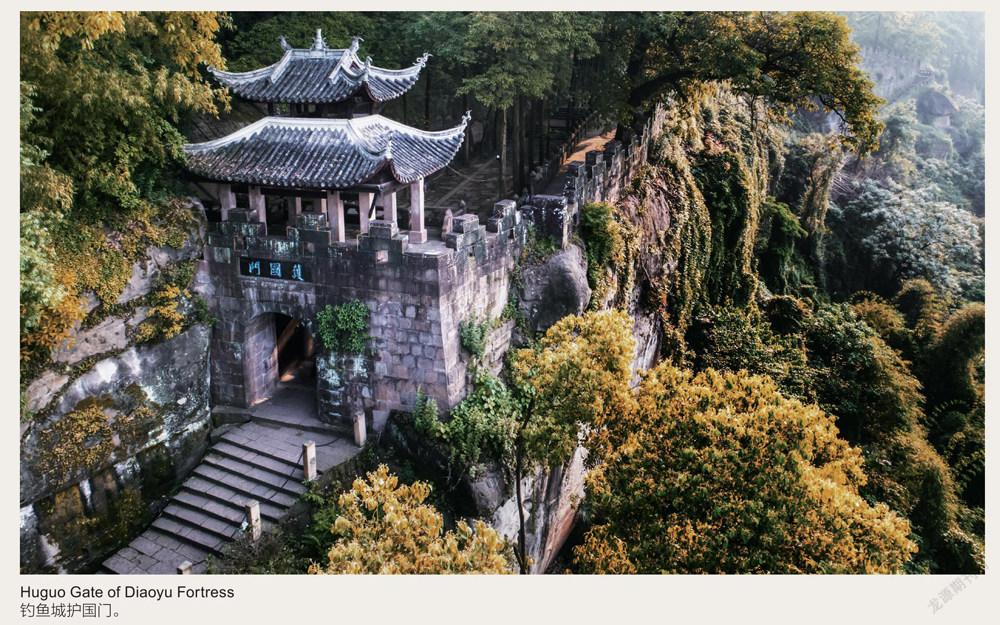
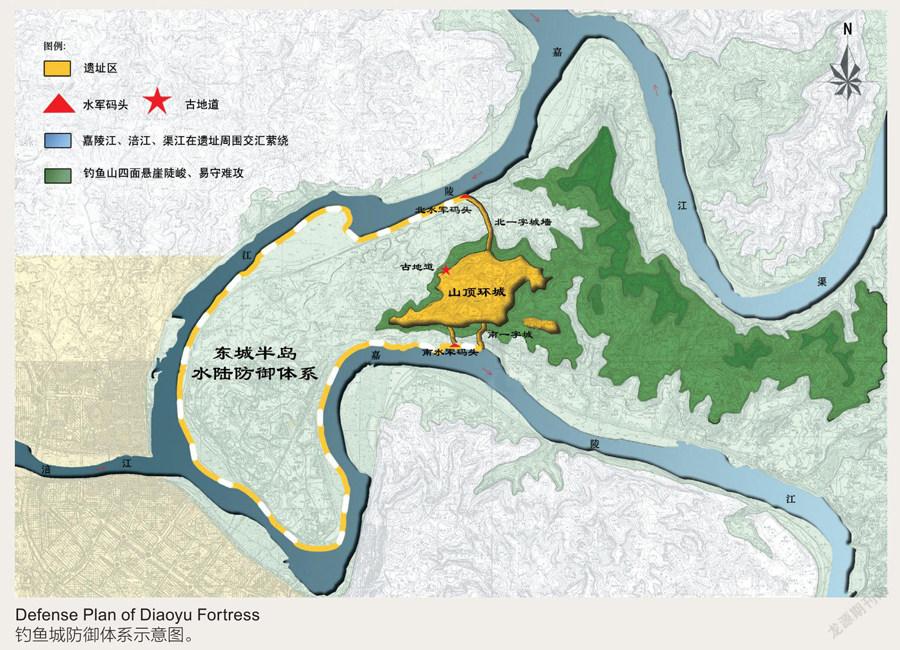
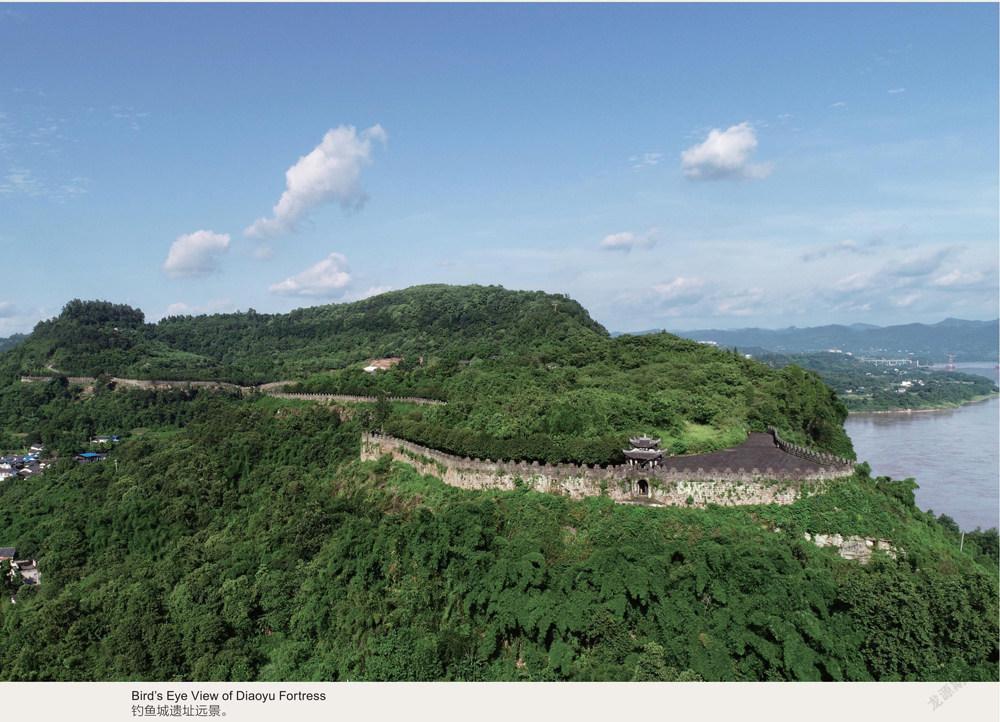
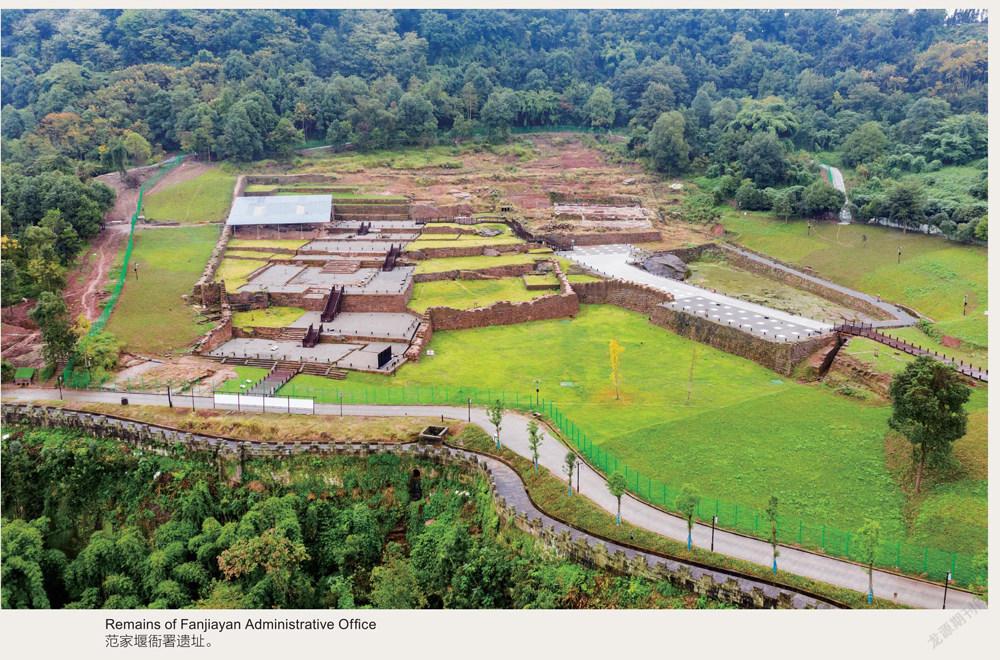
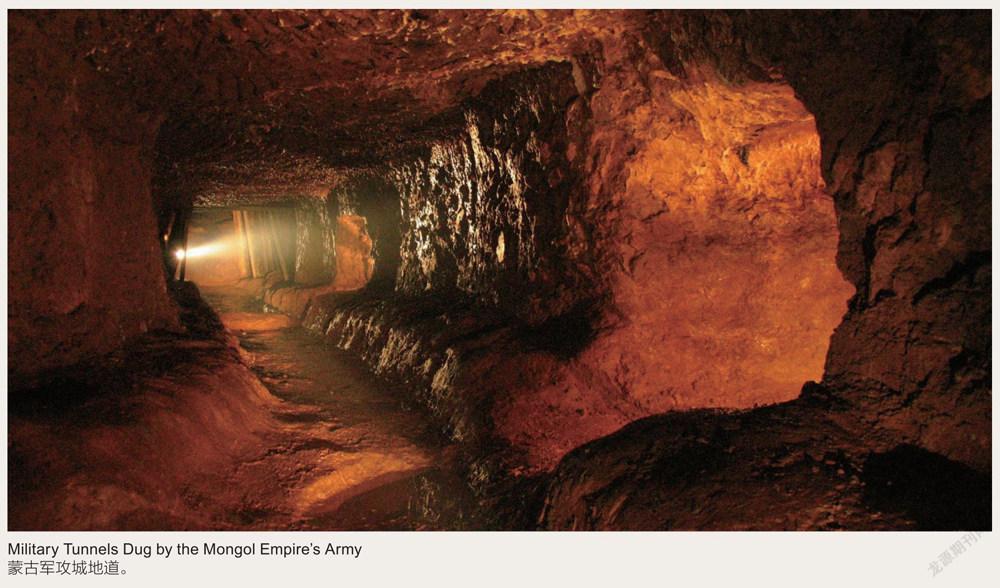
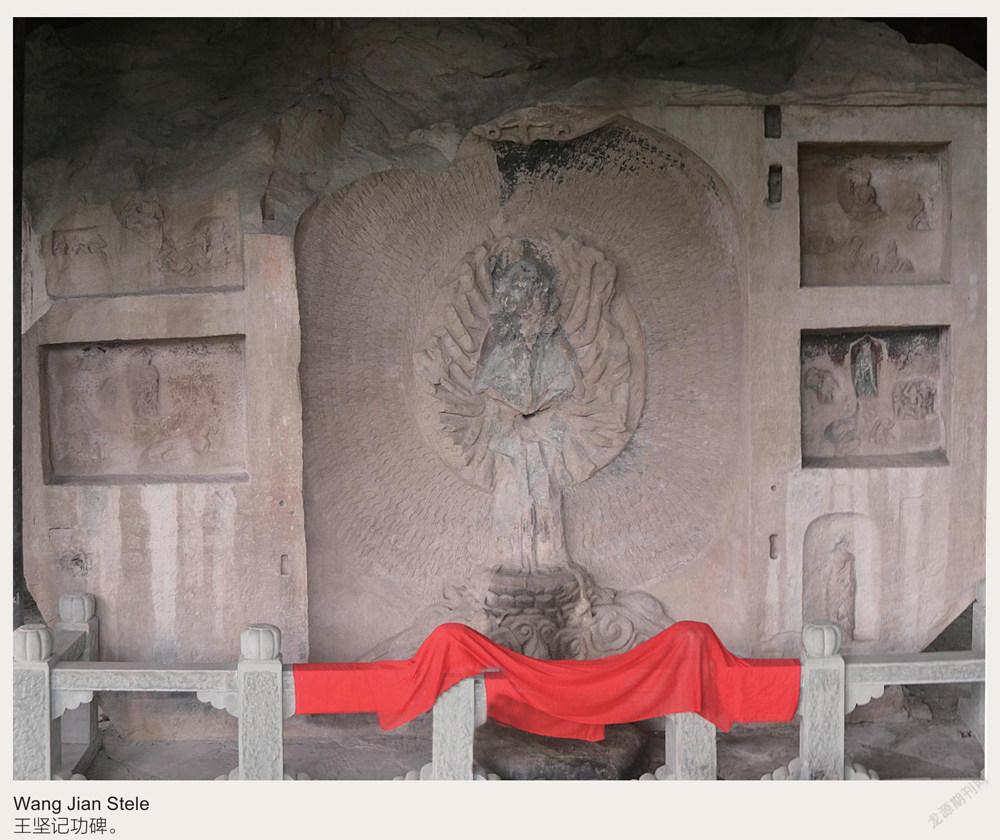

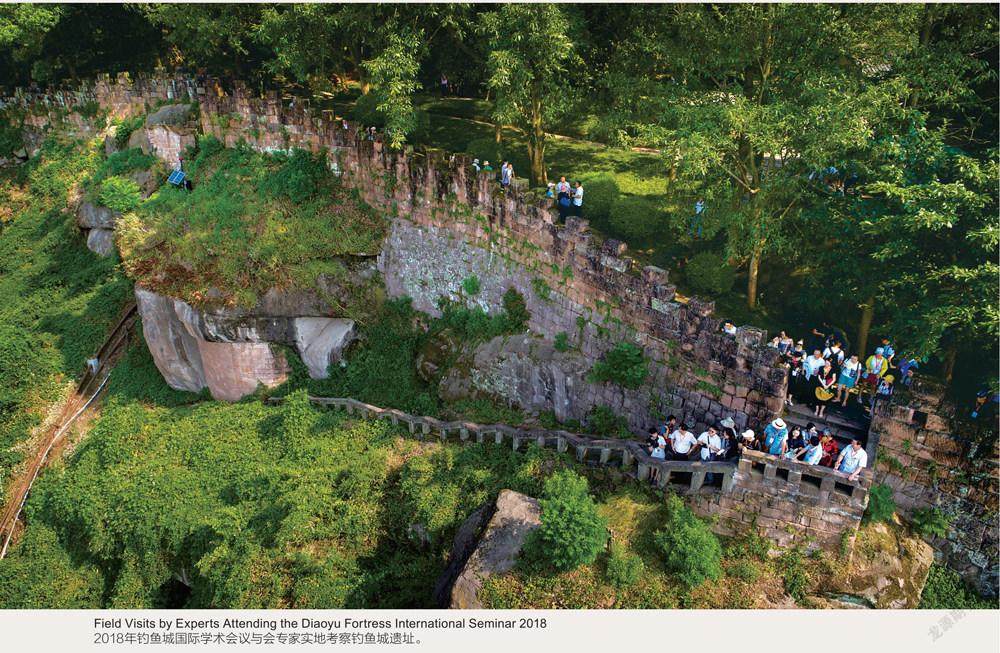
Diaoyu Fortress is located on the Eastern Peninsula of Hechuan District, Chongqing. On the three sides, the Eastern Peninsula is surrounded by wide waters of Jialing River that is joined by Qujiang River and Fujiang River. Its only land access is in the east but with Diaoyu Mountain standing in the way. Due to its challenging geographies, the Eastern Peninsula has always been a strategic juncture in Chongqing and Sichuan since the ancient times.
合川釣鱼城遗址位于重庆市合川区的东城半岛上,半岛被嘉陵江三面环绕,嘉陵江支流涪江和渠江在这里交汇,水势浩淼,江面宽阔,唯一的东面陆路又被凸起的钓鱼山控扼,形势十分险要,自古为“巴蜀要冲”。
In the Song-Mongol (Yuan) War in the 13th century, Southern Song garrisons made good use of the difficult accessibility of Diaoyu Mountain to build the Diaoyu Fortress. Soldiers and civilians of the five counties in Hezhou were relocated to the fortress from places with no natural barriers. The troop of Xing Command, one of the four central armies, was led by capable military personnel to safeguard the Diaoyu Fortress.
在13世纪的宋蒙(元)战争中,南宋守军在东城半岛以钓鱼山为核心修筑钓鱼城,将无险可守的合州五县军民迁入,并委派得力将领率领四川四支中央军之一的“兴戎司”驻守该城。
Sitting on mountains and overlooking three rivers, this place became a strong fortification to protect Chongqing, capital of Sichuan in the Southern Song Dynasty.
从此山城雄峙,控扼三江,成为南宋四川山城防御体系的重要支撑点和四川首府重庆的屏障。
For 36 years, local civilians and soldiers defended Diaoyu Fortress tenaciously against the sieges launched by the Mongol army. The Great Khan Möngke, unable to take this place, died at the foot of this fortress. The Diaoyu Fortress, thus, had a profound and far-reaching influence not only on the Chinese history but also on the Mongol Empire’s expansion in Asia and Africa.
钓鱼城军民在这里“婴城固守”长达36年,成功抵御了所向披靡的蒙元军队对钓鱼城的多次围攻,导致了蒙古大汗蒙哥战死城下,对中国历史乃至亚非地区的战争形势产生了深远影响。
History: Unbreakable Diaoyu Fortress
历史:不可攻的钓鱼城
The Jin Dynasty collapsed in 1234 under the joint force of the Southern Song and the Mongol Empire but the Southern Song soon became the target of the Mongols. After the fall of the Jin Dynasty, Southern Song hoped to recover Kaifeng, Luoyang and Shangqiu but was deadly stricken by the Mongols in Luoyang. This battle in Luoyang in the first year of Duanping Era meant the breakup of the Southern Song-Mongols coalition and also served as an excuse of the Mongol Empire to invade Southern Song. In 1235, Ögedei Khan sent three columns of army into the Southern Song. The west flank led by Kadan, his second son, took the lead in breaking into Lizhou before occupying Chengdu, the capital of Sichuan. The previously prosperous Sichuan had fallen after the Mongol troops’ invasion.
1241 saw the death of Ögedei Khan and the Mongolian armies returning to the north. Internal conflicts and disputes had been popping up in the following ten years in the Mongol Empire which led to fast changes of Khans and leeched the possibility of starting any other wars. Therefore, Southern Song had a chance to rest and adjust the plans of defense.
In 1240, Peng Daya, Deputy Commander of Sichuan, realized that Chengdu had been indefensible so he decided to improve the defense infrastructure and system of Chongqing instead, building it into the “Anchor of Western Sichuan”. Meanwhile, Peng ordered General Gan Run to manage the defense of Hechuan and build the Diaoyu Castle to protect Chongqing by leveraging the existing buildings on the Diaoyu Mountain. This had laid the foundation for the construction of the Diaoyu Fortress.
In 1242, Emperor Lizong (r. 1224-1264) appointed Yu Jie as the Commander of Sichuan and Governor of Chongqing to manage the military, political and defensive affairs of Sichuan. Yu, after his inauguration, made Chongqing the commanding center for battles in Sichuan. He recruited capable people by promising them ranks and fortunes, pooling together talents and wisdom.
Ran Pu and Ran Jin from Bozhou responded to Yu’s call and came to join him. They pointed out that “Diaoyu Mountain enjoys unparalleled geographical advantages in Sichuan. People of Hezhou could be relocated to Diaoyu Mountain. Able leaders must be appointed for this stronghold and food should be stockpiled. In this way, this defense is even stronger than 100 thousand soldiers and it will be easy to safeguard Sichuan and Chongqing.” Their suggestion was accepted. Ran Pu and Ran Jin were dispatched to Hechuan as defensive managers and then they transferred soldiers and civilians of Hezhou to the Diaoyu Fortress.
In addition, over ten impregnable fortresses were built in critical junctures along the rivers in Sichuan. A unique defense network was gradually put in place. Sitting at the confluence of the Yangtze and Jialing River, Chongqing served as the center of this network. It was reinforced by three key links along the Yangtze, namely Lingyun City of Leshan, Shenbi City of Luzhou and Baidi City of Fengjie and supported by four fortresses namely a. Yunding City of Jintang in Tuojiang River, one of the branches of Yangtze River, b. Taihuo City of Langzhong in Jiangling River, c. Qingju City of Nanchong and d. Diaoyu Fortress of Hechuan.
“These newly-built strongholds scatter around. They are constructed by leveraging the landscapes of mountains and serve as administrative centers.” (Biography of Yu Jie, History of the Song Dynasty) Thus, these places were easy to defend but difficult to attack. Eventually, a deep defense system was established in Sichuan based on mountain fortresses, which were key positions and connected by rivers as transport routes. The Diaoyu Fortress was the hub of this system.
Later, Wang Jian was appointed as the Commander and Governor of Hezhou. He mobilized 170,000 local people to further improve and strengthen the defensive system. Embraced by the Jialing River, the Diaoyu Fortress was composed of a terrace on the top of Diaoyu Mountain, northern and southern I-shaped city walls, outer areas of the Eastern Peninsula and other surrounding areas. This strong fortification played a positive role in stopping the Mongols, protecting Chongqing, prolonging the Southern Song Dynasty and influencing the dynamics of the war.
After his accession to the throne in 1251, Möngke decided to attack Southern Song, sending troops to Sichuan and Chongqing many times only to be repulsed by the Song army. By 1258, Möngke Khan commanded the main force of the Mongol’s army to invade Sichuan from three flanks, successively taking down several fortresses in the northern and central parts of Sichuan. After that, their troops joined force in order to take the Diaoyu Fortress.
From February of 1259, the army of the Mongol Empire began to attack the Diaoyu Fortress on a large scale. First, it broke through the outer areas of the Eastern Peninsula and occupied the military wharf under the Diaoyu Fortress. The main section of the Diaoyu Fortress was then besieged and fierce attacks were launched against the terrace of the Diaoyu Fortress on multiple flanks.
However, under the able leadership of Wang Jian, the garrisons stopped the attacks by taking advantage of the precipitous terrains. For as long as five months, the main force of the Mongolian army was defended by the Diaoyu Fortress. Later in the scorching and rainy summer, the Mongol Empire’s army did poorly as they grappled with hot temperatures, humidity, and the raging diseases. In contrast, the Song armies, fully-supplied and in high spirits, defended the Diaoyu Fortress against series of the Mongol’s attacks.
In early June of 1259, Möngke Khan led his armies in a hope to capture the Diaoyu Fortress from its northwest. During the fierce fight, Möngke Khan was mortally injured by a stone projectile from a trebuchet, so Mongols had to stop their attack and withdrew from the fortress. When retreating, Möngke Khan died. His son Asutai took charge of the army and led them back to the north. The Diaoyu Fortress Campaign then came to an end and the Mongol Empire suspended its plan to conquer the Southern Song from its southern territories.
In 1260, Kublai succeeded his brother as the Khan. He adjusted the strategy on conquering Southern Song by shifting the focus from Sichuan in the upper reaches to Jinghu in the middle reaches of the Yangtze. Mongol Yuan’s troops in Sichuan adopted a pressing tactic to cut off the supplies of the Diaoyu Fortress since the Diaoyu Mountain was hard to occupy for its perilous terrain. They asked for permission to build a castle named “Wusheng” not far away to isolate and undermine the Diaoyu Fortress.
In 1276, Mongol armies approached Lin’an, capital of Southern Song. The Song court asked for surrender and the Song regime essentially perished. However, some mountain castles in Sichuan, including the Diaoyu Fortress, were still holding on. When Chongqing, capital of Sichuan fell in 1279, Diaoyu Fortress ran out of road for lack of reinforcement. The Mongol Yuan court sent Li Dehui of Xichuan Privy Council to persuade to surrender. To save the lives of the soldiers and civilians, Wang Li, Chief Commander of the Fortress, accepted the persuasion. After entering the fortress, Yuan armies transferred the soldiers and civilians on the mountain back to the original Hezhou at the foot of the mountain. Soon after, the Diaoyu Fortress was demolished. Since then, it has become a place for later generations to visit and review the past as a historical site.
公元1234年,蒙古軍与南宋军联合灭金后,蒙古军将攻击目标转向南宋。南宋政权却天真地以为金灭以后,就可以出兵河洛,收复失地,却在洛阳遭到蒙古军歼灭性的打击。这一史称“端平入洛”的军事行动,宣告了宋蒙联盟的破裂,也给蒙古进军南宋提供了口实。1235年,蒙古大汗窝阔台派兵分三路向南宋进攻,西路军由窝阔台第二子阔端率领,首先突破利州路,打开四川门户,接着南下,攻陷四川首府—成都。蒙古大军在蜀地大肆烧杀劫掠,繁华的四川从此衰落。
1241年窝阔台卒,蒙古大军班师北还,此后十年,蒙古内部纷争不断,数易其主,无暇发动对宋战争,因此给南宋王朝暂时喘息和调整布防提供了机会。
1240年,四川制置副使彭大雅已意识到成都残破,难以据守,故苦心经营重庆城的城防设施,使重庆城作为“西蜀之根本”。同时,彭大雅派遣将军甘闰主持合川防务,在钓鱼山山寨的基础上修建钓鱼山城,“图险保民”,以之作为重庆的屏蔽,为此后钓鱼城的修筑,建立良好的基础。
1242年,宋理宗任命余玠为四川安抚制置使兼知重庆府,主持四川军政防务。余玠到任后,正式将重庆作为指挥全蜀作战的大本营,并高爵重赏,广纳贤士,集思广益。播州贤士冉璞、冉琎兄弟受其感召,前来献策,指出“蜀口形胜之地莫若钓鱼山,请徙诸此,若任得其人,积粟以守之,贤于十万师远矣,巴蜀不足守矣”。余玠接受了冉氏兄弟的建议,派遣他们前往合川主持钓鱼城防务,将合州治所及属县军民迁至钓鱼城。与此同时,余玠在四川几大江河的关键节点接连修筑了十余座山城,逐渐形成了以嘉陵江汇入长江处的制置司城重庆为核心,以长江沿线的乐山凌云城、泸州神臂城、奉节白帝城这三安抚司城为基干,以长江支流沱江上的金堂云顶城、嘉陵江上的阆中大获城、南充青居城、合川钓鱼城这四戎司城为支撑的山城网络。这些新筑的城邑皆“因山为垒,棋步星分,为诸郡治所”(《宋史·余玠传》),易守难攻。从而建构了以山城水寨为防御要点,以大江大河为交通线路,点线结合,相互策应,具有一定防御纵深的四川战区山城防御体系,而钓鱼城就是这个防御体系的枢纽。此后,王坚以兴元都统合州知府的身份驻守合州,又调动合州5县民众计17万人,进一步完善钓鱼城的城防设施。钓鱼城因此成为由钓鱼山山顶环城、南北一字城及嘉陵江围合的东城半岛外郭城及附属城防设施组成的坚固堡垒,在阻御蒙元兵于外,遮蔽渝夔于内,对延长宋祚,左右战争局势发挥了积极的作用。
1251年,蒙哥即位为大汗,决意攻宋,多次派兵骚扰川渝地区,都被宋军击退。至1258年,蒙哥汗统帅蒙军主力分三路进入四川,接连攻破四川中北部的多座山城,诸军会合在钓鱼城下。从次年二月起,蒙军开始大举进攻钓鱼城,首先攻破了东城半岛郭城,并进占钓鱼城下的水军码头,将钓鱼城主城围困起来,并从多个方向对钓鱼城山顶环城发起猛攻。钓鱼城守军在王坚率领下,利用钓鱼城奇险的地形地貌,阻挡住了蒙军,蒙军主力受阻于钓鱼城下达5个月之久。当战役进入到炎热多雨的夏季以后,蒙军不耐四川的湿热气候,疾病在军营蔓延,导致战斗力下降。而钓鱼城宋军屡挫强敌,粮食丰足,斗志旺盛。这年的七月上旬,蒙哥汗亲自击鼓指挥蒙军从钓鱼城西北猛攻内城,在激烈的战斗中,蒙哥汗被宋军发射的石弹砲风所伤,蒙军被迫停止攻城并撤离钓鱼城。在撤退途中,蒙哥汗伤重不治,跟随他征蜀的蒙古军由其子阿速台率领北还,钓鱼城战役至此宣告结束,蒙古南下灭宋的计划也就此暂时告一段落。
1260年,忽必烈即位为蒙古大汗,调整了攻宋策略,将先前以长江上游的四川为攻宋主要方向,改为以长江中游的京湖地区作为攻宋的主要方向。在四川地区,蒙元四川驻屯军采取步步为营、以城对城的紧逼战术,以“钓鱼山险绝,不可攻,奏请就近地筑城曰武胜,以扼其往来”,从而使钓鱼城如同被困的孤岛,限制了钓鱼城作用的发挥。1276年,蒙元军进逼南宋首都临安,宋廷请降,南宋政权事实上覆灭,但包括钓鱼城在内的南宋四川部分山城仍在坚守。1279年,南宋四川首府重庆陷落,钓鱼城孤城无援,情况危急。元廷派西川行院李德辉前来招降。为保城中军民安全,当时的钓鱼城主将王立决定开城降元。元军占领钓鱼城后,将山上军民回迁至山下的原合州治所,不久后就拆毁了钓鱼城,钓鱼城从此成为遗址,成为后人怀古游览的场所。
Values: Masterpiece of Construction in Cold Weapon Era
價值:冷兵器时代筑垒工程的杰作
The Diaoyu Fortress was a fortification that created miracles of the war in the Middle Ages as a well-developed defense system was put in place by leveraging the advantageous natural conditions. It has been the best-preserved ancient battlefield with the most unique defense mechanism in China. The value of the Diaoyu Fortress lies in that it is a prime example of defensive mountain castle making the best of the geographical advantages. The Diaoyu Fortress Campaign had a considerable and far-reaching impact as it diverted the development trajectory of Song and Mongol Yuan and indirectly influenced the world history.
The values of the Diaoyu Fortress are exemplified in following aspects:
Firstly, Diaoyu Fortress served as a transportation hub and a defensive node in the military defense system set by the Southern Song to guard against Mongol Yuan’s armies from the east and the south. Among the military castles built in the late Southern Song, Diaoyu Fortress boasted the most ideal location, the most systematic planning and the most inaccessible terrains. That was why it could hold on for a long time even when it was heavily besieged. It was a fine example of military planning and building as well as a masterpiece of fortification in the Cold Weapon Era.
When Sichuan was invaded by Mongol armies, cities were mostly destructed and a large number of civilians were displaced or killed. The former military and administrative system collapsed. Under such challenging circumstances, the Diaoyu Fortress became an important part of the system replanned and reestablished in the Song-controlled region in Sichuan Basin. In this new system, the Diaoyu Fortress played a paramount role in safeguarding Chongqing and buttressing the castles on the upper reaches of Jialing River.
The Diaoyu Fortress was built on the peninsula embraced by the Jialing River, Fujiang River and Qujiang River. Transportation was convenient. Vast regions in the northeast Sichuan Basin could be reached by moving northward along the three rivers while Chongqing could be reached by going downstream along the Jialing River when it joined the Yangtze. The steep cliffs of the Diaoyu Mountain were ideal for building fortresses on the mountain top. Imposing mountains around it were favorable for defense rather than massive attack. On the mountain top was a flat land for armies and civilians to station, fertile soil, and sources of spring water. It was suitable for agricultural production which ensured adequate supply for the needs of long-lasting attacks and defenses. Thus, it was a premium location to build the fortification. The Diaoyu Fortress became an impregnable military stronghold as it was built on the top of an inaccessible mountain and surrounded by three rivers as moats.
The planner of the Diaoyu Fortress mapped out Hezhou on the Eastern Peninsula surrounded by Jialing River. The Jialing River served as a natural moat while the Diaoyu Mountain across the region as natural walls of the main part of the fortress. This was how the defense system worked. The Eastern Peninsula was the outer area mainly for agricultural production that satisfied the minimum food demands of armies and civilians. The precipitous cliffs and natural ravines around the main fortress provided conditions for strong defense. In this area, there were essential facilities for both the city and military fortress. Natural ponds and manmade pools in the main fortress ensured consistent water supply. With mountains as city walls, rivers as moats, arable land, water supplies, supportive civilians and prepared armies, the Diaoyu Fortress was a masterpiece of military fortress of the ancient times.
Building on the original geographic advantages, the builders of Diaoyu Fortress made full use of the topographic features of the Eastern Peninsula and Diaoyu Mountain to construct the outer, middle, and inner fortresses, which strengthened defense in depth and enabled flexible defense mechanisms adjustable to wartime situations. The outer fortress was the first layer of the core defense line. Two long lines of the Chinese character “one” (“一”)-shaped city walls were built respectively from the north and south of the Diaoyu Mountain to the riverside with the vast Jialing River and its bank as natural barriers. Altogether they encircled the Eastern Peninsula to defend against the raid of Mongolian infantry and cavalry along the river and ensure agriculture production and people’s daily life in the outer city. The middle fortress was the second layer of the core defense line. A ring-like city wall surrounding the top of the Diaoyu Mountain made this fortress the main part of the Diaoyu Fortress. Built on the mountain in conformance with the terrain and elevation differences, taking advantage of the steep cliffside, a defense wall with a relative height difference of 20-30 meters was constructed on relatively smooth terrains. On the ring city wall, eight gates were set in precipitous areas where arrows, trebuchets, and cannonballs in crossfire could reach. The city wall is lined with wide horse paths on the top, which were linked with inner roads, forming a well-connected traffic network that ensured the speedy movement of garrison troops to wherever in need. By using natural ravines on the top of the mountain, the builders divided the middle fortress into many defense areas. Thus, even if one area was compromised, the enemy would not be able to continue the attack and be forced to stop before reaching the inner fortress, the third defense layer. It was built on the precipitous cliffs on the last terrace of the mountaintop highland with natural steep rocks in the west, north, and south as natural walls and manually built walls in the east, forming an impregnable defense bastion and command center on the top of the mountain.
Thanks to its unconquerable defense system and invincible city walls, Diaoyu Fortress could endure and survive attacks for 36 years, becoming a miracle of the world’s ancient military history.
Diaoyu Fortress was the ancient battlefield between the Southern Song dynasty and the Mongol Empire during the Middle Ages. Years ago, Southern Song defenders inflicted heavy loss on the Mongols after persistent resistance. The death of Möngke Khan at Diaoyu Fortress in 1259 resulted in drastic changes in the development of the Mongol Empire. It also slowed down the demise of the Southern Song Dynasty and indirectly affected the course of history for China and beyond.
Möngke’s death at the Fortress forced the armies of the Mongol Empire to cease their third expedition towards Eurasia, leaving opportunities for Egypt in North Africa to repel the Mongolian invaders. In 1253, Möngke dispatched his younger brother Hulagu as the commander-in-chief to launch the third conquest, trying to further conquer West Asia and North Africa. The Mongol armies conquered many ancient countries on the Arabian Peninsula in West Asia and wielded swords toward Egypt. A road to Africa was about to open. Right at that time, after receiving the news of his brother’s death, Hulagu immediately withdrew his major troops to fight for the throne of Khan, leaving merely a small division in Syria. Mamluk Sultanate of Egypt took the chance to wage wars. In the autumn of 1260, Qutuz led 120,000 Mamluk soldiers to fight the remaining Mongolian forces led by Ked-Buqa in Galilee. With an overwhelming advantage of troops in number, Egypt declared the final victory, saving Arab and North Africa from being occupied by the Mongols and claiming the end of external expansion by the Mongol Empire.
Because of its profound historical significance and legacy, Diaoyu Fortress has been listed in the fourth batch of major historical and cultural sites protected at the national level and was included in the World Cultural Heritage Tentative List in China in 2012.
釣鱼城遗址是以雄奇壮丽的自然山水为依托,以独具匠心的防御体系为主体,创造了世界中古史上战争奇迹的城防要塞,是中国迄今保存最为完好、城防体系极具特色的古战场遗址。钓鱼城遗址的价值,显现在它是古人有效利用特殊地理环境,规划而成的防御性山城的杰出范例。钓鱼城战役的发生,改变了宋蒙历史的发展方向,间接影响世界历史的发展进程,具有突出的普遍意义。
钓鱼城遗址的价值主要体现在以下几个方面:
首先,钓鱼城遗址是南宋王朝为了抵御蒙(元)军南下东进而设立的军事防御体系的交通枢纽和防御节点。在南宋末期营建的众多军事性质的城市中,钓鱼城的建城选址最为科学,城市规划最为系统,城防建设最为险要,因而钓鱼城能够在敌重兵围攻的困难环境长期坚守。它是军事城市规划营建的典范,是冷兵器时代筑垒工程的杰作。
钓鱼城是在四川地区被蒙古突袭,原有城市大半摧毁,原有人口大多散亡,原有军政体系已经解体的严峻形势下,在四川盆地南宋控制区域内重新规划建设的行政体系和军事体系的重要组成部分。在这个新营建的军政体系中,钓鱼城既起着拱卫南宋四川首府重庆的作用,又担负支持嘉陵江水系上游诸城的责任,地位极其特殊和重要。
釣鱼城选址于嘉陵江、涪江、渠江三条大江汇流所形成的半岛之上。从这里沿三江北上,可达四川盆地东北部广大地区;顺嘉陵江南下,就是位于嘉陵江与长江交汇处的四川首府重庆,交通十分便利。钓鱼山山顶层台之间,有悬崖峭壁,为修筑城池提供了坚固高大的基础。周围为崇山峻岭,不利于大规模进攻而有利于据险守卫。山顶有平地,可供军民驻扎,加以山上土地肥沃、泉眼丰富,使得钓鱼城具备充分的农业生产条件,能为长期攻防提供足够的保障,极其适合军事堡垒的建设。钓鱼城的营建巧妙利用了三江、半岛、孤山的地形地貌。使得这里成为易守难攻的军事要塞,显现了“以山为城、以水为池”的选址特性。
钓鱼城规划者利用嘉陵江大回转形成的东城半岛作为整个合州城市的规划范围,以环绕半岛的嘉陵江河道作为外城的天然城壕,以阻断半岛的钓鱼山作为主城的天然城墙,规划建设了钓鱼城山城水寨防御体系:以东城半岛做为外城,作为合州的基本农业生产区域,这里种植的粮食可以保障全城军民最低限度的生活需求。钓鱼山主城区域周围有高崖绝壁和天然沟壑等天险便于防守。区域内有州县建置城市必备的功能单元,以及军事城堡所需的功能单元。主城内部还有多处天然水塘和人工井池,为全城人长期困守山顶提供了充足水源。这种以山为城,以河为池,有地可耕,有水可用,有民可依,有兵可战的城市规划,是古代军事城市规划的杰出作品。
在充分利用天然地理优势的规划之上,钓鱼城营建者充分利用了东城半岛和钓鱼山的山形地貌,建造了外、中、内三重城池,加大了防御纵深,可以根据战时形势需要实施弹性防御。外城是钓鱼城核心防线的第一层,利用宽阔的嘉陵江和沿江堤防作屏障,并在钓鱼山南北修建从山上直到江边的横城墙—一字城,将东城半岛封闭起来,以防止敌方步骑沿江突入东城半岛,保障外城内农业生产和日常生活的正常进行。中城是钓鱼城核心防线的第二层,围绕钓鱼山顶修筑环顶城墙,使之成为钓鱼城的主城。中城城墙依山就势,充分顺应地形高差,利用天然山崖峭壁,在局部地形平缓地带修筑相对高差达20~30米的险墙,环顶城墙设城门8座,皆开辟在城上箭簇炮石交叉攻击范围的险峻处。城墙上铺设有宽大的马道,马道与城中道路连接,构成了四通八达的交通路网,守御方通过交通路网迅速机动兵力至危险地段。尤其值得一提的是,钓鱼城的营建者利用山顶的天然沟壑,将中城分划为若干防御区域,即使攻城方突破中城处,也难以扩张突破,会受阻于内城之前。内城是钓鱼城核心防线的第三层,营建者利用钓鱼山顶的最后一级台地的陡峭山壁,西、北和南三面直接以天然陡岩为墙,东部以人工砌筑的城墙为主,形成了山顶坚固的防御堡垒和指挥中心。
正是依托其自身完善的防御体系和城防工程,钓鱼城才能坚守36年而从未被攻破,成为世界古代战争史上的奇迹。
其次,钓鱼城遗址是中古时期南宋与蒙古间重大战役的古战场,当年南宋居民在这里长期坚守,给围攻的蒙古军造成了重大损失。尤其是1259年发生的导致蒙古大汗蒙哥死于钓鱼城下的重大事件,直接导致了蒙古国家的发展方向变化,延缓了南宋政权的覆灭时间,并间接影响了中国历史甚至世界历史的发展进程。
蒙哥死于钓鱼城下,导致了蒙古帝国军队对欧亚的第三次远征被迫停止,并为北非的埃及提供了击退蒙古留守军队的机会。1253年,蒙哥派遣其弟旭烈兀统帅蒙古西征军进行第三次西征,试图继续征服西亚和北非。蒙古西征军征服了西亚阿拉伯半岛上的众多古国,兵锋直指埃及,通往非洲的道路即将打开。就在此时,旭烈兀得到蒙哥死于钓鱼城下的消息,于是立刻率领蒙古西征军主力东撤,回师蒙古参加汗位争夺,只在叙利亚留驻了一支不大的军队。埃及马穆鲁克(Mamluk)王朝趁此机会出兵作战,1260年秋,忽都思率领12万马穆鲁克大军与怯的不花率领的留守蒙古军在加利利交战,埃及军队凭借军队数量上的巨大优势战胜了蒙古军,从而挽救了阿拉伯和北非地区免遭蒙古占领,宣告了蒙古帝国向外扩张的终结。
正由于钓鱼城遗址重要的历史价值和纪念性价值,钓鱼城被列为第四批全国重点文物保护单位,并于2012年列入“中国世界文化遗产预备名单”。
Protection and Utilization: Appropriate Preservation and Restoration of the Ruins to Recreate the Marvelous Scenes in History
保护与利用:合理保持与修复“废墟”,复现古代游览奇观
With the demise of the Southern Song Dynasty, there was no point for Diaoyu Fortress to continue with the war. The last defending general Wang Li surrendered under the condition of guaranteeing the safety of soldiers and residents, symbolizing the end of the organized military resistance of the Sichuan authority in the Southern Song Dynasty. After the war ended for Diaoyu Fortress, the soldiers and residents moved to the old Hezhou (today’s Hechuan). Previously well-known for its resistance against the Mongols and Yuan forces, Diaoyu Fortress was reduced to ruins after being demolished by the Yuan forces, and became a place reminiscent of a period in history for future generations. In the late Qing Dynasty, the White Lotus staged rebellions. In order to avoid social turmoil, those soldiers and residents again moved from the indefensible Hezhou city to Diaoyu Mountain and rebuilt the walls and gates of the middle fortress as the last bastion to fight against the White Lotus rebels. Most of the main constructions of today’s Diaoyu Fortress, such as the walls and gates of the upper areas, were built then.
The major area of the Diaoyu Fortress site covers about 2.5 square kilometers, including the ring city, the main city, south and north one-shaped city walls, and south and north military wharves, with a total length of almost 7,320 meters of the walls at different sections. There are eight gates on the ring city wall, namely, Shiguan Gate, Huguo Gate, and Xiaodong Gate in the south; Xindong Gate and Qinghua Gate in the east; Zhenxi Gate and Qisheng Gate in the west; and Chuqi Gate in the north. The walls and gates of the upper areas of the outer city of the middle fortress were refortified in the Qing Dynasty. But other constructions have been maintained as they were in the Southern Song Dynasty like the inner-city wall and the south and north one-shaped city walls, the south military wharf, and the footholds for the trebuchets, as well as some remained tunnels used during attacks of the Mongol armies. The outer fortress of the main part of the Diaoyu Fortress, near the largest pond within the site, is home to the foundation remains of large public buildings in the Song Dynasty. Among them, the Fanjiayan building complex is a well-preserved, rarely-seen relics site of a Southern Song administrative office after large-scale archaeological excavation. This relics site covers a large area with highly-organized structure, a clear central axis, and well-identified functions. In the inner fortress of the main part of the Diaoyu Fortress sit heritage sites such as Buddhist cliff carvings of the Song Dynasty, stone inscriptions of previous dynasties, Huguo Temple of the Ming and Qing dynasties, and Zhongyi Temple, as well as the foundation remains of the large building complex “Nine Pots” from the Song Dynasty, among other sites such as the Shizhao County Government, Wudao Government, military training grounds, large ponds and wells, and ancient tunnels.
The Diaoyu Mountain, where the Diaoyu Fortress site is located, was a renowned place of interest back in the Song Dynasty. Literati gathered around here to visit the historic sites, pay homage to ancestral temples, honor the martyrs, and give rein to their literary talents. These tourists in ancient times chose their itineraries very wisely. There were two routes, one by land and one by water. The land route allowed tourists to travel across the old city of Hechuan and walk to the foothill by a country trail where they could enter the main fortress near Qisheng Gate. Passing through Fanjiayan Pond, tourists could then climb up to enter the inner fortress, where they could visit the mountaintop cultural heritage sites centering around Huguo Temple before returning the way they had come. The water route allowed tourists to board at Hechuan Old City Pier and land at the south military wharf of Diaoyu Fortress before climbing up from the south one-shaped city wall to enter the main fortress. After sightseeing at the mountaintop around Huguo Temple, tourists can exit via Chuqi Gate from the north of the fortress, pass through the north one-shaped city wall to board at the north military wharf and sail along the Jialing River to arrive at the Hechuan Old City Pier (described in Local Wonders by Song Zhumu). This water route was dubbed by the Song people as “A Tour of Wonders”. Today, the construction of the Caojie Avionics Hub project on the Jialing River in the lower reaches of the fortress allows river water to return for dozens of kilometers upstream of the Hechuan old city. The possibility of building a “Good Tourism” model can be explored, which connects the famous cultural sites within the backwater section of the Qujiang River in Caojie, such as Laitan Ancient Town and the Second Buddha Temple from the Song Dynasty with the Diaoyu Fortress, as a way to reproduce the ancient “Tour of Wonders” combining both the water and land routes.
南宋王朝覆灭后,钓鱼城失去了继续作战的意义,钓鱼城最后一任守将王立以保证全城军民生命为条件献城投降,南宋四川军政当局的有组织的抵抗基本结束。钓鱼城战火熄灭后,全城军民被迁回合州旧城,钓鱼山城被元军拆毁,这座抗击蒙元的名城从此变成废墟。清代晚期,四川白莲教作乱,为了躲避动荡的社会,合州城内的军民放弃了难以守卫的州城,又一次上了钓鱼山。他们在山上南宋钓鱼城中城的旧址上重建了城垣和城门,将山城作为抵御白莲教徒的最后堡垒,现在钓鱼城主城的上部城墙和城门,大都是这次重建后的遗留。
现存的钓鱼城遗址主城区面积约2.5平方公里,由钓鱼山山顶环城及主城,南、北一字城墙及南、北水军码头共同组成,现存各段城墙总长约7320米。环山城墙设城门8座,分別为城南的始关门、护国门、小东门;城东的新东门、青华门;城西的镇西门、奇胜门;城北的出奇门。现在钓鱼城上主城的外城城垣和城门,上部大都是清代重建,但内城垣及南北一字城墙、南水军码头、水寨炮台等设施,仍保留南宋時期的原貌,并有蒙军当初攻城的隧道遗留。在钓鱼城主城的外城内,也就是城内最大的天池附近,分布着宋代大型公共建筑群的基址,其中范家堰遗址规模宏大、布局规整、轴线清晰、性质明确,是目前国内罕见的经过大规模考古发掘、保存极其完整的宋代衙署遗址。在钓鱼城主城的内城,除了宋代的摩崖佛教造像、历代碑刻、明清护国寺、忠义祠等地面遗存外,还有宋代“九口锅”大型建筑群基址,以及石照县衙、武道衙门、军营校场、天池泉井、古隧道等遗迹。
钓鱼城遗址所在的钓鱼山早在宋代就是当地的名胜古迹,宋蒙(元)战争以后更有不少文人慕名前往,游览古迹,瞻仰祠庙,缅怀烈士,抒发豪情。这些古代的游客选取的游览线路很有讲究,有陆路与水路两种游览路线。陆路是从合川旧城乘渡船过江,然后沿着乡间小径行至山麓,大致从奇胜门处入主城,经范家堰大天池,再登山至内城,以护国寺为中心游览山顶文物古迹,然后沿原路返回。水路则是从合川旧城码头登船,顺水而下,至钓鱼城南水军码头停船上岸,从南一字城登山入主城。在山顶以护国寺为中心游览,其后从城北出奇门出城,沿北一字城至北水军码头登船,放舟顺嘉陵江而下,直抵合川旧城码头(宋祝穆《方舆胜览》)。这条水路游钓鱼山的路线,宋人称其为“此游观之奇也”。今天,随着钓鱼城下游嘉陵江上的草街航电枢纽工程的修建,江水长年回水至合川旧城上游数十公里处,是否可将草街至渠江回水范围内的著名的文物古迹,如涞滩古镇和宋代二佛寺等,与钓鱼城遗址串联起来,开展水陆结合的游览,将复现古代游览的奇观,是推行“善行”旅游的理想模式。
Nomination Timeline of Hechuan Diaoyu Fortress on the World Cultural Heritage List
合川钓鱼城遗址申报世界文化遗产历程
In September 2012, the Diaoyu Fortress was included in the World Cultural Heritage Tentative List in China.
2012年9月,钓鱼城遗址成功列入《中国世界文化遗产预备名单》。
In May 2015, to accelerate the nomination of Diaoyu Fortress on the world cultural heritage list, the CPC Hechuan District Committee and Hechuan District Government established the Office of the Leading Group for the Nomination of Hechuan Diaoyu Fortress on the World Cultural Heritage List.
2015年5月,为加速推动钓鱼城遗址申报世界文化遗产工作,合川区委、区政府组建了合川区钓鱼城遗址申报世界文化遗产工作领导小组办公室。
In July 2015 and July 2018, two Diaoyu Fortress International Seminars were held. A dozen of experts and scholars from home and abroad conducted research and discussions on the heritage site mainly through field trips and academic seminars.
2015年7月及2018年7月,分别举办两届钓鱼城国际学术会议,来自国内外的数十名专家学者通过实地考察、学术大会等方式对钓鱼城遗址进行了研究探讨。
In February 2016, the Measures for the Protection of the Chongqing Diaoyu Fortress Heritage Site were promulgated. The Diaoyu Fortress nomination file and the protection plan of the Diaoyu Fortress Heritage Site were completed, which refined the Diaoyu Castle site in accordance with the international context to meet three of the six selection criteria of outstanding universal value of world cultural heritage, which are criteria iii, iv, and vi.
2016年2月,颁布《重庆钓鱼城遗址保护办法》。完成钓鱼城遗址申遗文本、钓鱼城遗址保护规划,按照国际语境提炼出钓鱼城遗址符合世界文化遗产突出普遍价值6条评价标准中的3条,分别是标准iii、iv、vi。
In March 2019, the archaeological excavation project of the ancient administrative offices (“yashu”) in Fanjiayan Complex of the Diaoyu Fortress site was awarded as one of the “National Top Ten New Archaeological Discoveries of 2018”.
2019年3月,钓鱼城范家堰衙署遗址考古发掘项目荣获“2018年度全国十大考古新发现”。
In November 2020, the Diaoyu Fotress World Cultural Heritage Nomination Book Series was published.
2020年11月,《釣鱼城遗址申报世界文化遗产系列丛书》出版。
In October 2021, it was listed as a key cultivation project for world cultural heritage nomination in the 14th Five-Year Plan for National-Level Cultual Heritages, and was selected for the Special Plan of the National Major Heritage Site Protection and Utilization 14th Five-Year Plan.
2021年10月,钓鱼城遗址被列为国家文物事业“十四五”规划申遗重点培育项目,并入选国家大遗址保护利用“十四五”专项规划。
图片/合川区申遗事务中心提供
